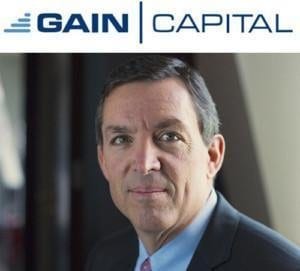LeapRate Exclusive Interview… It would be an understatement to offer that the Q1 results recently announced by Forex brokerage house Gain Capital Holdings Inc (NYSE:GCAP) were disappointing.
Revenues were down nearly 50% from the previous quarter. Revenues from retail clients were down 60%. The company posted a $19 million loss.
Was this a one-time anomaly, or indicative or some sort of sea-change shift in the metrics of FX brokerage sector?
How are the regulatory changes around the world, but especially in Europe, affecting the business?
We posted these questions and more to GAIN Capital CEO Glenn Stevens. Here is what he had to say.
LR: Hi Glenn, and thanks for joining us today. Despite the not-so-great numbers that GAIN Capital reported for Q1, you seem to remain optimistic for the business looking forward. Can you explain a little more about the main sources for your optimism?

Glenn Stevens, CEO of GAIN Capital
Glenn: Thanks for having me. Yes, soft market conditions impacted our first quarter results, but we view this as a temporal issue and not a long-term trend. While clearly disappointing, we can’t control the markets and over short periods of time, such as a reporting quarter, our results may fluctuate. However, when looked at over a longer period there is more stability in our performance. For example, if you look at our combined results for Q4’16 and Q1’17, we reported $175.4M of revenue and $23.5M of EBITDA and a revenue per million of $107, right in line with our trailing 12-month average.
We are focused on creating long term value for our shareholders. To do that, we concentrate on what we can control: how well we execute against our strategic plan, how well we control costs in our business and how well we service our customers. In these areas, we are very optimistic.
Specifically, we are actively investing to provide the best experience for our customers, which we feel will ultimately drive increased customer acquisition and engagement. We recently launched our new Active Trader program for FOREX.com clients in the US and Canada to offer tiered pricing discounts to our high volume clients. We’ve also just introduced a new web-based platform in partnership with Trading View, offering full trading functionality along with their advanced charting tools. Late last month, we launched a new City Index website in the UK and are introducing a major upgrade of our mobile trading apps next month.
In addition to these projects, we have a full pipeline of other customer-facing enhancements that will help us grow share in markets where we already operate or help us enter new markets and attract new client segments. We’re also looking at targeted acquisitions to help us accelerate our strategic plans by adding new capabilities, products and services or distribution channels.
We are already seeing traction from our efforts; we posted strong operating metrics in Q1, adding more than 14,000 new retail accounts in the quarter, which excludes the new FXCM U.S. clients we acquired, and realizing an 18% YOY increase in retail client assets. In addition, our acquisition of FXCM’s U.S. client assets, which closed on February 25, cemented FOREX.com’s position as the #1 provider of retail FX in the United States with over 50% market share. In the month after the deal closed, nearly 13,000 former FXCM clients became active on our platform.
All in all, despite the slow start to the year, we are building momentum now through our efforts and are looking forward to a successful 2017.
LR: From our analysis, it looks like the key issue in Q1 was the drop in retail revenue capture – that is, your retail trading volumes were decent, averaging over $200 billion per month, but revenue earned per million volume was well down from historical levels. Is that indicative of a long-term trend in the Retail FX industry and increased price competition, or was there some kind of anomaly you saw in Q1? Can you give some insight into how Q2 has started?
Glenn: Yes, the decline in retail revenue was the key issue in Q1. January and February were particularly challenging months with extremely low volatility keeping traders either on the sidelines or looking for opportunities within range-bound markets. Fundamentals improved in March and have continued to improve in April, pointing towards more normalized revenue levels as we move through Q2.
As such, we don’t believe the Q1 results speak to a macro trend. Instead, they highlight the impact that low volatility and narrow trading ranges can have on our business.
LR: How do you view the regulatory changes underfoot in Europe, such as banning bonus payments, limiting trading leverage, and (in some jurisdictions) advertising restrictions? It would seem to us that this would bode well for the larger brokers who traditionally didn’t rely nearly as much on those things.
Glenn: Overall, we feel there are positive aspects to the increased regulatory oversight happening not just in Europe but also in the US and elsewhere. The industry proliferated very quickly over the last decade and clearly not all providers were operating to the same set of standards. Our hope with all regulation is that it strikes the right balance, with rules that help increase protections for retail investors while leveling the playing field for providers. What we don’t want to happen is for the rules to become overly onerous so that they limit choice or access for retail investors who want to trade leveraged products and understand the risks involved.
Specifically regarding the FCA proposal, we appreciate the time and consideration the FCA is giving to the feedback they’ve received both from the industry as well as from retail traders themselves. We understand that FCA received over 4000 pieces of feedback, which is likely more than they expected.
We are in a somewhat unique spot as GAIN operates a broadly diversified business, which includes a retail FX/CFD business spanning seven regulatory jurisdictions, a U.S.-based retail futures business and an international institutional trading business, GTX. So, we are not overweight in any single regulated market. This is not to infer we are immune to any kind of regulatory headwinds, but we’ve navigated evolving regulations for closing in on two decades now and are accustomed to engaging with regulators, contributing to their understanding of the industry and retail customers and adapting to change.
With all the changes happening in Europe, and pending the final outcome of the FCA proposal, it appears as if increased regulation is here to stay. I do agree all these changes will likely have a disproportionate impact on 2nd and 3rd tier brokers, and I expect we’ll see more industry consolidation as a result. I suspect having a fewer number of well capitalized, high quality providers is the ultimate goal of the regulators because it will allow them to have a high level of oversight on the remaining firms and implement the customer protections they are seeking.
